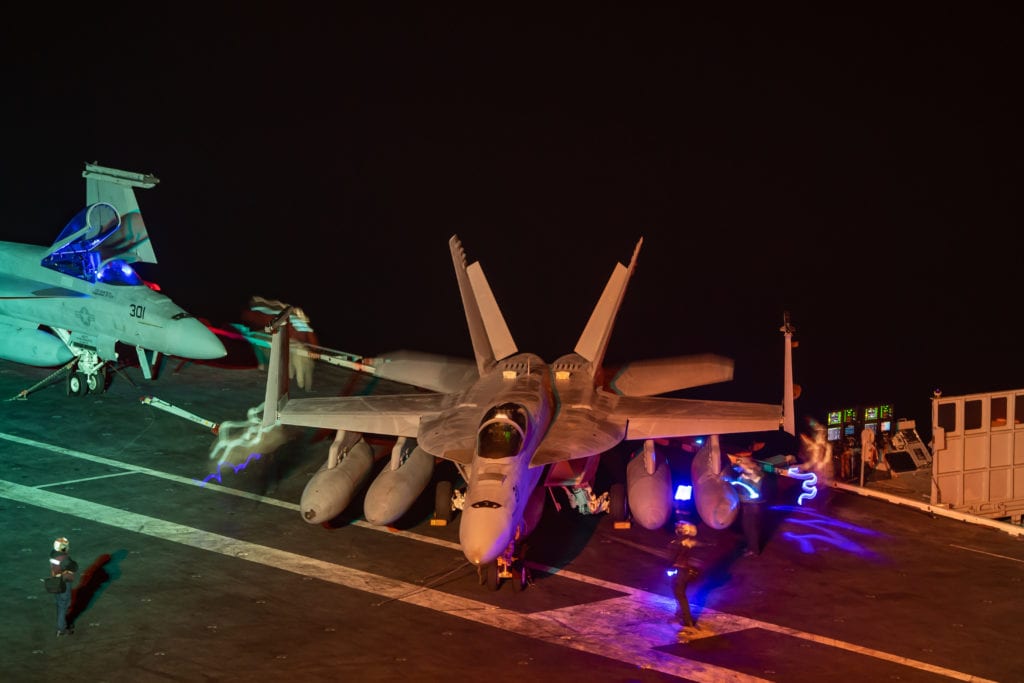
ARLINGTON, Va. — The Navy’s director of air warfare told the Congress that the Navy is on track to eliminate its shortfall of strike fighter aircraft by 2025.
Testifying July 13 before the Tactical Air and Ground Forces subcommittee of the House Armed services Committee, Rear Adm. Andrew J Loiselle, the director of air warfare in the Office of the Chief of Naval Operations, was questioned by Rep. Vicky Hartzler, (R-Missouri) — in whose state the Boeing F/A-18E/F Super Hornet strike fighter is built — about the Navy’s decision not to seek additional procurement of more Super Hornets in fiscal 2022 and the effect on the Navy’s current strike fighter shortage.
“We have taken the F-35C portion of our 44 strike fighters [per carrier air wing] and reduced that from two squadrons of F-35s down to a single squadron but then increased then number of [aircraft] from 10 to 14,” Loiselle said.
The admiral pointed out that the Navy’s adversary aircraft requirements changed to replace some legacy F/A-18s with ex-Air Force F-16s and ex-Swiss Air Force F-5 fighters instead of Super Hornets. He also said the Fleet Readiness Center at Naval Air Station North Island, California, “has been able to return 28 Super Hornets from long-term down status and put those back in the fleet.
“We believe that those improvements [will] reduce our strike fighter shortfall to zero by 2025 based on current year analysis,” Loiselle said.
The admiral said the two Service Life Modernization (SLM) for the Super Hornets “will have the additional capacity at the 2025 period in question to take additional SLM [aircraft] should our current analysis be revised, and we require that additional capacity. We believe the infrastructure will support additional modifications to the Block III” version of the Super Hornet.
Hartzler asked about the Super Hornets being inducted for SLM having more corrosion evident than was predicted, noting that alleviating the corrosion would add time to conduct an SLM.
Loiselle said the SLM line was about halfway through modifying the first 30 of the Block II Super Hornets planned for the process, noting the first 30 aircraft were intended to enable the artisans to learn the needs of the aircraft.
“I agree 100% that there was damage beyond expectations from a corrosion perspective on some of the initial aircraft,” he said. “However, Boeing has seen significantly improved condition in the aircraft that we are now submitting for SLM. So, with the number of Block II Super Hornets in our inventory, compared with the number of Block II Super Hornets that we intend to conduct SLM on, that allows us some selectivity in those [aircraft] we put through the modification line. We’re learning in this process and we’re now conducting inspections prior to induction looking at these hard areas to identify whether or not the corrosion present in those aircraft justifies inclusion in out SLM process or whether or not we might look at a different to conduct that on.
“But right now, we’re continuing to learn and continuing to bring down the time associated with getting the aircraft through the SLM process,” he said. “We anticipate that by the 2025 timeframe we should be in full swing on two lines at one year per SLM aircraft at that point in time in 2023 and after, coming of the line in a full 10,000-hour modification in full Block III configuration.”
Loiselle also said the Navy “currently is executing a multi-year procurement of F/A-18s — 78 total. We’ve got 70 left to deliver and [those will be delivered] between now and fiscal year ’25. So they are continuing to add to our total of F/A-18s. That’s why I think we can get to SLM and modifications of current F/A-18s after that time frame.”
He noted the Navy lists an unfunded priority of five F-35Cs to accelerate transition to its desired mix of fourth- and fifth-generation fighters.
- Insitu Going Strong at 30, Focusing on Maritime Operations - April 8, 2024
- Navy Awards Boeing Additional Funds for MQ-25 Drones for Testing - April 3, 2024
- Benign 4th Fleet AOR Useful for Unmanned Vehicle Operationalization, Admiral Says - March 27, 2024






